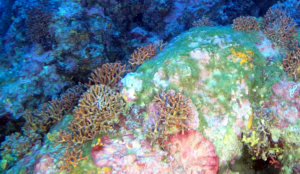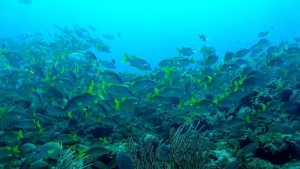The young yellowmouth barracuda, Sphyraena viridensis, or yellow barracuda is a predatory ray finned fish from the family Sphyraenidae, the barracudas, which is found in the warmer waters of the western Atlantic Ocean and the Mediterranean Sea. It is often confused with the European barracuda Sphyraena sphyraena. Sphyraena viridensis has a long, fusiform body with a long, streamlined pointed snout which has a long mouth lined with two rows of sharp, fang-like teeth and a jutting lower jaw. There are no scales on the properculum, unlike the Mediterranean Barracuda which has scales on both the anterior and posterior margins of the preoperculum. There are numerous transverse dark bars on the dorsum and these are longer, extending below the lateral line, towards the head while in Sphyraena sphyraena they do not extend to the lateral line. giovane Barracuda mediterraneo

young Yellowmouth Barracuda – giovane Barracuda mediterraneo – Sphyraena viridensis – www.intotheblue.it
Generally the colouration is a countershaded dark above, silvery below and the barring fades on dead specimens. Juveniles are described as being dark yellow or greenish in colour. Sphyraena viridensis averages smaller than Sphyraena sphyraena growing to a standard length of 65 cm, although the average length is 35–40 cm. but specimens up to 114.5 cm have been caught of the Azores. The rod caught record is 10.2 kg which was caught off Lanzarote in the Canary Islands in 2007. The exact distribution of Sphyraena viridensis is unclear because of confusion with Sphyraena sphyraena. It occurs in the eastern central Atlantic around the Azores, Nadeira, Cape Verde Islands and the Canary Islands and has been recorded in the eastern Mediterranean off Lebanon. It has also been recorded in the Mediterranean in the Adriatic Sea, Aegean Sea, off Israel, Algeria, Corsica and Sicily.

young Yellowmouth Barracuda – giovane Barracuda mediterraneo – Sphyraena viridensis – www.intotheblue.it
In summer they form schools of up to 180 fish, although most schools number 30-40 fish, in areas where there are strong currents. These schools are predominantly made up of sub-adult fish with the smaller fish nearer to the surface and the larger, usually female, fish at the bottom of the school at depths of up to 30m. In winter the only aggregations are small groups of juveniles in shallow bays. No territorial behaviour was observed. Schooling is thought to be an anti predator defence and to facilitate mating with the smaller males being attracted to the larger females, in addition groups of barracudas were more successful in hunting prey fish than single fish. This species does not appear to mix with other barracuda species in mixed schools but there are reports of these fish associating with whale sharks in the Azores and an instance of them actively swimming towards a manta ray Mobula tarapacana.

young Yellowmouth Barracuda – giovane Barracuda mediterraneo – Sphyraena viridensis – www.intotheblue.it
In the Azores juveniles of Sphyraena viridensis are preyed upon by the lizard fish Synodus saurus, this predation shows that there is an overlap in habitat between the juvenile barracudas and the lizard fish which occur in sheltered, very enclosed bays with sandy substrates. Sphyraena viridensis is landed in small quantities in the eastern Mediterranean by fishermen using in trammel-nets and beach-seines. It has been reported from markets in Turkey but it is generally caught as a bycatch, although as numbers increase in the Mediterranean it may be becoming a more important species for fisheries.
(extract from Wikipedia)
 English
English Italiano
Italiano



